Mon Jul 07, 2008 12:25 am
engguy, I'd dispute that as being a blanket statement. Both the P-3 and CV580 have almost instantaneous reaction due to their constant speed, geared turbine drive and also have temp limiting systems that will prevent most over-temp conditions (and thus most over-power situations), something that you don't have with a piston. I agree that with the PT-6 and the pure jets you can have significant power lag, but with geared turbines like the T56/501D and the Garrett, you don't have much lag. In fact, when I was working around the 580s & 240s, the 501D usually was set and stabilized at takeoff power faster than the R2800.
The reason that the pistons are still around? Economics & quantity. There are very few P-3s, L-188s, or CV-580s available for conversion to tankers. There are more than enough DC-6s and DC-7s already tankers available. If there was a viable replacement for the DC-6s and DC-7s, I would guarantee you that would see all of the pistons gone.
The reason that the pistons are still around? Economics & quantity. There are very few P-3s, L-188s, or CV-580s available for conversion to tankers. There are more than enough DC-6s and DC-7s already tankers available. If there was a viable replacement for the DC-6s and DC-7s, I would guarantee you that would see all of the pistons gone.
Mon Jul 07, 2008 12:24 pm
You know the stupid thing is that the Forest Circus won't use the CV-580 air tankers because they are twin engine and not four, and the crazy thing is the CV-580 is an over powered work horse!
Scott...........
Scott...........
Mon Jul 07, 2008 1:15 pm
Oh agreed. The 580 has 4000 HP a side whereas the plane as it was originally built flew just fine with 4000 HP total.
It's funny that the Forest Service refuses to use any twins. All those TurboCats are state contract only and seem to be doing just fine.
Air Tahoma's got a pair of 580s that have been waiting for a contract to convert, but I've still not heard if the State of Washington stepped up to the plate after cancelling the PBY contract like they did.
It's funny that the Forest Service refuses to use any twins. All those TurboCats are state contract only and seem to be doing just fine.
Air Tahoma's got a pair of 580s that have been waiting for a contract to convert, but I've still not heard if the State of Washington stepped up to the plate after cancelling the PBY contract like they did.
A few pictures from Butler Aircraft
Mon Jul 07, 2008 2:10 pm
CAPFlyer,
The Washington DNR (Department of Natural Resources/Washington State) doesn't need to contract for Convair 580 tankers because they can just order them from Canada when needed.I worked fires with the CV 580 tankers when I was based in Moses Lake.They do an excellent job.The following link will take you to Con Air's site where there's a pdf brochure on the CV 580 available for download.
http://www.conair.ca/?action=conair_main&page_id=4200
The Washington DNR (Department of Natural Resources/Washington State) doesn't need to contract for Convair 580 tankers because they can just order them from Canada when needed.I worked fires with the CV 580 tankers when I was based in Moses Lake.They do an excellent job.The following link will take you to Con Air's site where there's a pdf brochure on the CV 580 available for download.
http://www.conair.ca/?action=conair_main&page_id=4200
Mon Jul 07, 2008 2:44 pm
Larry, you're misunderstanding. When the Washington DNR cancelled the PBY contract, several of the state's fire deparments and other orginizations were pushing the state to get another aircraft on state contract, not ones from Vancouver or ConAir. It's fine that they can get ConAir to send tankers (when they're available), but their rates are more than what the state was getting charged by Flying Fireman for the PBY, which has many concerned when the state is already facing a budget crunch.
Last I'd heard was that there was a push for the legislature to order the DNR to contract for another aircraft, but that was it. My hope is that they do contract for another "in state" aircraft as I think it's a bad idea to just have aircraft "on loan" in a state where forest fires are a problem. They had a problem in the past with that, which was why the PBY stuck around as long as it did.
Last I'd heard was that there was a push for the legislature to order the DNR to contract for another aircraft, but that was it. My hope is that they do contract for another "in state" aircraft as I think it's a bad idea to just have aircraft "on loan" in a state where forest fires are a problem. They had a problem in the past with that, which was why the PBY stuck around as long as it did.
A few pictures from Butler Aircraft
Mon Jul 07, 2008 5:32 pm
CAPFlyer,
I thought that the latest discussion was on the value of the CV 580 as an air tanker.From what I can tell from the Automated Flight Following site that shows tanker activity,among other things,Aero Flight's CL 215 Tanker 262 is flying out of Deer Park,which was PBY Tanker 85's old base.My understanding on the Wa DNR not renewing the Tanker 85 contract was an airworthiness issue rather than problems pertaining to their performance.I'd heard rumors of severe corrosion.
I worked with Tanker 85 fairly often when I was based in Wenatchee,Couer d' Alene and Moses Lake.Eric Johnson was the pilot in those days and I enjoyed watching him work.I don't know what the contracting situation is between the DNR and Tanker 262,but I'll ask around.By the way,for those who might ask,the Automated Flight Following (AFF) government site is restricted and they don't allow access to anyone who isn't directly involved in the business.
I thought that the latest discussion was on the value of the CV 580 as an air tanker.From what I can tell from the Automated Flight Following site that shows tanker activity,among other things,Aero Flight's CL 215 Tanker 262 is flying out of Deer Park,which was PBY Tanker 85's old base.My understanding on the Wa DNR not renewing the Tanker 85 contract was an airworthiness issue rather than problems pertaining to their performance.I'd heard rumors of severe corrosion.
I worked with Tanker 85 fairly often when I was based in Wenatchee,Couer d' Alene and Moses Lake.Eric Johnson was the pilot in those days and I enjoyed watching him work.I don't know what the contracting situation is between the DNR and Tanker 262,but I'll ask around.By the way,for those who might ask,the Automated Flight Following (AFF) government site is restricted and they don't allow access to anyone who isn't directly involved in the business.
Mon Jul 07, 2008 6:21 pm
The CV-580/WaDNR thing was an addendum to the CV-580 as a Tanker issue. 
As for the PBY contract, my understanding was concern over the age more than any airworthiness issues directly related to that aircraft. The aircraft was maintained throughout the year, even though it really only flew during the fire season, so I have doubts that there were any corrosion issues that weren't dealt with. If there were, then Bud would have backed out of the contract instead of WaDNR cancelling it.
As for the PBY contract, my understanding was concern over the age more than any airworthiness issues directly related to that aircraft. The aircraft was maintained throughout the year, even though it really only flew during the fire season, so I have doubts that there were any corrosion issues that weren't dealt with. If there were, then Bud would have backed out of the contract instead of WaDNR cancelling it.
Mon Jul 07, 2008 6:22 pm
Larry;
Go to the AAP message board there is an interesting talk about the PBY there. I know Matt has one of his CL's on that contract now. Hope things are well for you up north. I wish the Forest Service would use the 580 here in the states I know there would be plenty of happy fire fighting folks with a few of those in the old fleet!
Scott.......
Go to the AAP message board there is an interesting talk about the PBY there. I know Matt has one of his CL's on that contract now. Hope things are well for you up north. I wish the Forest Service would use the 580 here in the states I know there would be plenty of happy fire fighting folks with a few of those in the old fleet!
Scott.......
Mon Jul 07, 2008 6:42 pm
Dunno what the discussion on the AAP board is, but I did find this -
http://www.spokesmanreview.com/local/st ... ?ID=251185
Interesting that Bud is contesting the new contract award and it also states that WaDNR chose not to renew due to age and Federal Regulations. As has been said before, age should not be the only factor in such decisions, and it's sad to see that it may have been. It also appears the CL-215 is 10 times more expensive to operate than the PBY (and about 3 times more than a 580), so it's really hurting the state budget, although I'm sure the federal funds will help some.
http://www.spokesmanreview.com/local/st ... ?ID=251185
Interesting that Bud is contesting the new contract award and it also states that WaDNR chose not to renew due to age and Federal Regulations. As has been said before, age should not be the only factor in such decisions, and it's sad to see that it may have been. It also appears the CL-215 is 10 times more expensive to operate than the PBY (and about 3 times more than a 580), so it's really hurting the state budget, although I'm sure the federal funds will help some.
Tue Jul 08, 2008 6:03 pm
CAPFlyer,
Here you go, this is off of the AAP message board:
Posted by Tankerdog (69.144.228.58) on June 22, 2008 at 20:16:32:
http://www.youtube.com/watch?v=DqPpYLp81-U
not to say anything about 27 CL-215 hull losses. Now that the fire season is underway is no time to go looking for replacements ?????
Posted by Blur (68.189.141.5) on June 23, 2008 at 23:36:35:
Unfortunately, this PBY (T-85) has become the scapegoat in this saga.
I believe Washington DNR and USFS have had safety concerns about the piloting of T-85 and blamed the aircraft to rationalize not renewing the contract. I know one of the lead plane pilots reported his safety concerns to the USFS last summer.
Multiple times last summer the PTT was pushed instead of the drop button. On one such occasion we watched the aircraft get so close to the terrain we thought its belly brushed the ground. The ATGS later said that was the closest he had ever seen a tanker from "going in." You could hear the excitement of the crew over the freq. during this ordeal as the PTT was pressed.
Furthermore, the crew was often not where they were instructed to be, or where they reported that they were. On one such occasion four AT-802s were building nearly continuous line as the fire was 12 miles from the tanker base where they were hot reloading. Once T-85 showed up at the fire the 802s were put into holds at least twice while the ATGS had to track down T-85 as they were unsure of their position. The same day T-85 sat on the ground for over four hours waiting for the airport manager drive in from family camping trip to sell them fuel. Apparently the crew only carried company checks to cover their expenses and the fuel system was a self-serve card lock system.
It also didn't help promote the usability of the aircraft when at a fire near the Canadian border T-85 was scooping out of a lake about 15nm from the fire. A P-3 was reloading at Moses Lake about 105nm from the fire and the turn around time for both aircraft was nearly identical. In fact once the ATGS left the fire and started searching for T-85 because they couldn't be reached on any of the freqs. And were long overdue.
Now don't get me wrong with my statements above. I love the PBY. I have many fond childhood memories of watching T-85 scooping out of lakes around or rumble slowly overhead. I think the PBY, like other tankers, is a great firefighting tool if it is used properly.
Unfortunately, over the last few years T-85 has gotten a bad reputation. I think it is easiest for DNR to blame the aircraft as the problem and look for another platform.
Posted by Wilbur (69.224.71.214) on June 28, 2008 at 09:03:40:
By all reports, IA Captain Eric Johnson did great work with T85 for many years. Word is he was paid considerably less than a LAT copilot at AUC or Neptune, less than half what a SEAT pilot makes, to fly and maintain the PBY.
When he finally left for greener pastures, Bud Rude found a new guy to sit in his seat.
You get what you pay for (sometimes, for a while, if you're lucky).
Posted by matt (71.108.73.248) on July 01, 2008 at 03:57:31:
What a bunch of BS. I am sorry but DNR has no right to bring up the to tanker crashes in 2002. The PBY was built like a tank and was used from VIP transport to anti sub warfare. To top it all of the DC-4's, 6', and 7's are almost as old as the PBY and the are still flying. I also heard that the USFS had renewed the contract with tanker 85. I don’t know how true it is. If it is not someone please tell me.
Posted by Tankerdog (216.166.135.162) on July 01, 2008 at 11:16:27:
> By Martha Bellisle
> > Anchorage Daily News
> >
> > (Published April 6, 2001)
> >
> > Juneau -- A Senate Finance subcommittee wants to spend $700,000 on a pair of
> > Canadian firefighting airplanes that state fire managers say they don't
> > want, they didn't ask for and would not work well in Alaska.
> >
> > The CL-215 water bomber. (Bombardier Inc.)
> >
> > The Division of Forestry, in charge of battling Alaska's wildfires, asked
> > the Legislature for 20 more firefighters and a few new fire engines,
> > officials said this week in interviews. But Quebec-based Bombardier Inc.,
> > through its Juneau lobbyist, persuaded the subcommittee in charge of the
> > Department of Natural Resources budget to lease two of its CL-215 aircraft
> > anyway.
> >
> > "I was just stunned when I heard that they stuck $700,000 in my budget for
> > planes I didn't ask for," Joe Stam, fire program manager with the Division
> > of Forestry, said Tuesday.
> >
> > State Forester Jeff Jahnke said no one in the Senate Finance subcommittee
> > talked to Stam or other wildfire experts, who have done extensive studies on
> > these planes.
> >
> > "We have professional experts who are nationally recognized for their
> > expertise who don't believe this is the right aircraft," Jahnke said. "We're
> > all frustrated by the fact that we're not being listened to."
> >
> > The Bombardier lobbyist, former Alaska state forester Tom Boutin, has gained
> > the lawmakers' attention, however.
> >
> > Boutin said this week that he has talked to members of the subcommittee
> > frequently about the plane's value, especially in fighting fires that may
> > erupt from the swaths of beetle-killed spruce trees in Southcentral and
> > around Anchorage. The amphibious air tanker would be used for a fast initial
> > attack on a fire, he said.
> >
> > He was paid $27,728 in 2000 to lobby for Bombardier, according to the Alaska
> > Public Offices Commission. Boutin said he also works for the company in
> > other parts of the country.
> >
> > The Canadair CL-215 was in the middle of a notorious Alaska corruption case
> > in the early 1980s. State Sen. George Hohman was jailed for offering to
> > share a bribe with another legislator to get support for an appropriation to
> > buy two of the aircraft.
> >
> > There's no connection between that incident and the current disagreement,
> > said Sen. Loren Leman, chairman of the subcommittee in charge of the
> > Department of Natural Resources budget. He said lawmakers are "really
> > concerned about this fire season.
> >
> > "The faster we can respond to save homes and lives, the better off we will
> > be," said Leman, R-Anchorage. The Canadian planes, he said, are "very
> > effective, but they're expensive."
> >
> > Leasing the aircraft would cost the state $9,958 a day and $1,298 a flight
> > hour, plus oil and fuel, according to the most recent proposal made by
> > Bombardier to the Division of Forestry.
> >
> > The air tanker currently used by state firefighters costs much less --
> > $3,000 a day and $1,200 a flight hour, plus oil and fuel -- according to the
> > department.
> >
> > Leman said the subcommittee recommended adding the planes to the
> > department's budget, despite rumblings from forestry officials, because
> > lawmakers believed that the opposition was coming from managers and that
> > "there was fair amount of support at worker bee level."
> >
> > "That's not true," Jahnke said this week, adding that he had just come out
> > of a workshop with firefighters from across the state in which they
> > discussed the CL-215. Everyone agreed that the agency's other needs should
> > come first.
> >
> > "We don't see it as a broadly used piece of equipment," he said. "It's a
> > narrowly used piece of equipment. It doesn't compare with the effectiveness
> > of a helicopter, for example, that can transport people and deliver water."
> >
> > "For that kind of money, we could get twice as many personnel as we need,"
> > Stam said. "Give us another air tanker. It carries twice as much."
> >
> > The state's existing tankers can haul 3,000 gallons of water-foam retardant.
> >
> > The Canadian plane can skim along a lake and scoop up 1,400 gallons of water
> > in 10 seconds, Boutin said. It can inject a short-term retardant foam into
> > the tank full of water, then dump it onto a fire through two doors in the
> > fuselage.
> >
> > Pulling water out of a nearby lake can save valuable time when a wildfire is
> > in its early stages, Boutin said.
> >
> > State fire managers said the craft have significant limitations, however.
> >
> > Besides being expensive and having a limited load capacity, they are slow,
> > don't work well in high winds and are not good at flying long distances,
> > Stam said. Plus, using water with short-term foam is less effective than the
> > long-term chemical retardants used in conventional fire bombers, he said.
> > And, he said, many of Alaska's wildfires are not near lakes.
> >
> > The U.S. Forest Service and the Bureau of Land Management conducted a study
> > on the Canadian aircraft in 1998 while considering contracting for their use
> > on wildland fires, according to a summary report that compared the Canadair
> > CL-215 and CL-415 with conventional retardant aircraft.
> >
> > The federal agencies collected "recent operational experience" data from
> > agencies in Canada, Europe and the United States, including the Los Angeles
> > County Fire Department and California Division of Forestry. Lawmakers in
> > California scrapped plans to use the CL-215 after evaluating their
> > effectiveness, the report said.
> >
> > Natural Resources Department officials in Alaska gave that summary report to
> > the budget subcommittee, Stam said. It's being reviewed, Leman said.
> >
> > In addition to Leman, the subcommittee includes Sens. Randy Phillips,
> > R-Eagle River; John Torgerson, R-Kasilof; Drue Pearce, R-Anchorage; and
> > Georgianna Lincoln, D-Rampart. With no objections, they adopted the DNR
> > budget recommendations as a package, including the aircraft.
> >
> > The full Senate Finance Committee has not completed work on the budget for
> > the next fiscal year. Leman's staff said Thursday that instead of waiting,
> > some committee members wanted to add the planes to the supplemental budget
> > bill now being considered, so the money would be available for the fire
> > season that begins this month.
> >
> > Reporter Martha Bellisle can be reached at mbellisle@adn.com and
> > 907-586-1531.
Posted by Bob (72.197.173.100) on July 02, 2008 at 01:24:20:
Wish I knew how to send this to the airhead county supervisors in San Diego.
Posted by Tankerdog (216.166.135.162) on July 02, 2008 at 11:57:43:
www.spokesmanreview.com/local/story.asp?ID=251185
The latest news, if it is in the news it must be true
Posted by Tankerdog (216.166.135.162) on July 02, 2008 at 12:13:01:
Canadair CL-415 crash on Evia island, Greece
On July 23, 2007 a Canadair CL-415 amphibian water-bomber crashed while fighting fire in a wildland-rural interface area near the town of Styra, on the island of Evia in Greece. Both pilots were killed on the spot.
The fire started in the morning of that day. It picked up momentum quickly, due to the high temperature (42 o C), low humidity and strong wind, burning pines, shrubs, and agricultural cultivations. Initial attack failed. As the fire moved towards the town of Styra and the surrounding wildland-rural interface area, seven Canadair water-bombers were dispatched in an effort to control the blaze. One of these planes, according to eye-witnesses on TV reports, flying only a few meters above the ground and after releasing its water load, failed to clear the slope. One of the wings touched the ground and the plane crashed into the hillside between two houses. Both pilots were killed.
Investigation of the accident is underway. However, it seems quite likely that the accident is the result of the extreme work load and pressure that the pilots, the firefighting planes of the national fleet and the contracted heavy lift helicopters have endured for the last month, due to the high number of fire starts, the difficult fire weather conditions and the ineffectiveness of the ground forces. These conditions have resulted in excessive use of the aerial means for extended attack on large fires under adverse conditions, often trying to protect villages and people on the ground.
The plane was built in 2001 and was the latest addition to Greece's water bomber fleet. It had been delivered in March 2004 and had approximately 1400 flight hours.
Two more Canadair CL-215 water-bombers experienced engine failures in the two following days (24 and 25 of July) while firefighting in western Greece. Fortunately they were both able to land safely, flying with one engine.
Ironically, on the same day as the Canadair crash in Greece, another Canadair CL-415 water-bomber crashed in Italy's central Abruzzo region, fighting a fire near S. Erasmo, Acciona. Italy is also struggling against wildfires fanned by soaring temperatures and strong winds. The pilot was killed while the co-pilot was seriously injured.
Dr. Gavriil Xanthopoulos
Research Forester ( Forest Fires)
Athens , Greece
Are you or have you ever flown any think over 12,500# I would be interested to know what qualifications you have to judge tanker flying.
Getting the press t publish your views does not automatically render them TRUE.
Scott..............
Here you go, this is off of the AAP message board:
Posted by Tankerdog (69.144.228.58) on June 22, 2008 at 20:16:32:
http://www.youtube.com/watch?v=DqPpYLp81-U
not to say anything about 27 CL-215 hull losses. Now that the fire season is underway is no time to go looking for replacements ?????
Posted by Blur (68.189.141.5) on June 23, 2008 at 23:36:35:
Unfortunately, this PBY (T-85) has become the scapegoat in this saga.
I believe Washington DNR and USFS have had safety concerns about the piloting of T-85 and blamed the aircraft to rationalize not renewing the contract. I know one of the lead plane pilots reported his safety concerns to the USFS last summer.
Multiple times last summer the PTT was pushed instead of the drop button. On one such occasion we watched the aircraft get so close to the terrain we thought its belly brushed the ground. The ATGS later said that was the closest he had ever seen a tanker from "going in." You could hear the excitement of the crew over the freq. during this ordeal as the PTT was pressed.
Furthermore, the crew was often not where they were instructed to be, or where they reported that they were. On one such occasion four AT-802s were building nearly continuous line as the fire was 12 miles from the tanker base where they were hot reloading. Once T-85 showed up at the fire the 802s were put into holds at least twice while the ATGS had to track down T-85 as they were unsure of their position. The same day T-85 sat on the ground for over four hours waiting for the airport manager drive in from family camping trip to sell them fuel. Apparently the crew only carried company checks to cover their expenses and the fuel system was a self-serve card lock system.
It also didn't help promote the usability of the aircraft when at a fire near the Canadian border T-85 was scooping out of a lake about 15nm from the fire. A P-3 was reloading at Moses Lake about 105nm from the fire and the turn around time for both aircraft was nearly identical. In fact once the ATGS left the fire and started searching for T-85 because they couldn't be reached on any of the freqs. And were long overdue.
Now don't get me wrong with my statements above. I love the PBY. I have many fond childhood memories of watching T-85 scooping out of lakes around or rumble slowly overhead. I think the PBY, like other tankers, is a great firefighting tool if it is used properly.
Unfortunately, over the last few years T-85 has gotten a bad reputation. I think it is easiest for DNR to blame the aircraft as the problem and look for another platform.
Posted by Wilbur (69.224.71.214) on June 28, 2008 at 09:03:40:
By all reports, IA Captain Eric Johnson did great work with T85 for many years. Word is he was paid considerably less than a LAT copilot at AUC or Neptune, less than half what a SEAT pilot makes, to fly and maintain the PBY.
When he finally left for greener pastures, Bud Rude found a new guy to sit in his seat.
You get what you pay for (sometimes, for a while, if you're lucky).
Posted by matt (71.108.73.248) on July 01, 2008 at 03:57:31:
What a bunch of BS. I am sorry but DNR has no right to bring up the to tanker crashes in 2002. The PBY was built like a tank and was used from VIP transport to anti sub warfare. To top it all of the DC-4's, 6', and 7's are almost as old as the PBY and the are still flying. I also heard that the USFS had renewed the contract with tanker 85. I don’t know how true it is. If it is not someone please tell me.
Posted by Tankerdog (216.166.135.162) on July 01, 2008 at 11:16:27:
> By Martha Bellisle
> > Anchorage Daily News
> >
> > (Published April 6, 2001)
> >
> > Juneau -- A Senate Finance subcommittee wants to spend $700,000 on a pair of
> > Canadian firefighting airplanes that state fire managers say they don't
> > want, they didn't ask for and would not work well in Alaska.
> >
> > The CL-215 water bomber. (Bombardier Inc.)
> >
> > The Division of Forestry, in charge of battling Alaska's wildfires, asked
> > the Legislature for 20 more firefighters and a few new fire engines,
> > officials said this week in interviews. But Quebec-based Bombardier Inc.,
> > through its Juneau lobbyist, persuaded the subcommittee in charge of the
> > Department of Natural Resources budget to lease two of its CL-215 aircraft
> > anyway.
> >
> > "I was just stunned when I heard that they stuck $700,000 in my budget for
> > planes I didn't ask for," Joe Stam, fire program manager with the Division
> > of Forestry, said Tuesday.
> >
> > State Forester Jeff Jahnke said no one in the Senate Finance subcommittee
> > talked to Stam or other wildfire experts, who have done extensive studies on
> > these planes.
> >
> > "We have professional experts who are nationally recognized for their
> > expertise who don't believe this is the right aircraft," Jahnke said. "We're
> > all frustrated by the fact that we're not being listened to."
> >
> > The Bombardier lobbyist, former Alaska state forester Tom Boutin, has gained
> > the lawmakers' attention, however.
> >
> > Boutin said this week that he has talked to members of the subcommittee
> > frequently about the plane's value, especially in fighting fires that may
> > erupt from the swaths of beetle-killed spruce trees in Southcentral and
> > around Anchorage. The amphibious air tanker would be used for a fast initial
> > attack on a fire, he said.
> >
> > He was paid $27,728 in 2000 to lobby for Bombardier, according to the Alaska
> > Public Offices Commission. Boutin said he also works for the company in
> > other parts of the country.
> >
> > The Canadair CL-215 was in the middle of a notorious Alaska corruption case
> > in the early 1980s. State Sen. George Hohman was jailed for offering to
> > share a bribe with another legislator to get support for an appropriation to
> > buy two of the aircraft.
> >
> > There's no connection between that incident and the current disagreement,
> > said Sen. Loren Leman, chairman of the subcommittee in charge of the
> > Department of Natural Resources budget. He said lawmakers are "really
> > concerned about this fire season.
> >
> > "The faster we can respond to save homes and lives, the better off we will
> > be," said Leman, R-Anchorage. The Canadian planes, he said, are "very
> > effective, but they're expensive."
> >
> > Leasing the aircraft would cost the state $9,958 a day and $1,298 a flight
> > hour, plus oil and fuel, according to the most recent proposal made by
> > Bombardier to the Division of Forestry.
> >
> > The air tanker currently used by state firefighters costs much less --
> > $3,000 a day and $1,200 a flight hour, plus oil and fuel -- according to the
> > department.
> >
> > Leman said the subcommittee recommended adding the planes to the
> > department's budget, despite rumblings from forestry officials, because
> > lawmakers believed that the opposition was coming from managers and that
> > "there was fair amount of support at worker bee level."
> >
> > "That's not true," Jahnke said this week, adding that he had just come out
> > of a workshop with firefighters from across the state in which they
> > discussed the CL-215. Everyone agreed that the agency's other needs should
> > come first.
> >
> > "We don't see it as a broadly used piece of equipment," he said. "It's a
> > narrowly used piece of equipment. It doesn't compare with the effectiveness
> > of a helicopter, for example, that can transport people and deliver water."
> >
> > "For that kind of money, we could get twice as many personnel as we need,"
> > Stam said. "Give us another air tanker. It carries twice as much."
> >
> > The state's existing tankers can haul 3,000 gallons of water-foam retardant.
> >
> > The Canadian plane can skim along a lake and scoop up 1,400 gallons of water
> > in 10 seconds, Boutin said. It can inject a short-term retardant foam into
> > the tank full of water, then dump it onto a fire through two doors in the
> > fuselage.
> >
> > Pulling water out of a nearby lake can save valuable time when a wildfire is
> > in its early stages, Boutin said.
> >
> > State fire managers said the craft have significant limitations, however.
> >
> > Besides being expensive and having a limited load capacity, they are slow,
> > don't work well in high winds and are not good at flying long distances,
> > Stam said. Plus, using water with short-term foam is less effective than the
> > long-term chemical retardants used in conventional fire bombers, he said.
> > And, he said, many of Alaska's wildfires are not near lakes.
> >
> > The U.S. Forest Service and the Bureau of Land Management conducted a study
> > on the Canadian aircraft in 1998 while considering contracting for their use
> > on wildland fires, according to a summary report that compared the Canadair
> > CL-215 and CL-415 with conventional retardant aircraft.
> >
> > The federal agencies collected "recent operational experience" data from
> > agencies in Canada, Europe and the United States, including the Los Angeles
> > County Fire Department and California Division of Forestry. Lawmakers in
> > California scrapped plans to use the CL-215 after evaluating their
> > effectiveness, the report said.
> >
> > Natural Resources Department officials in Alaska gave that summary report to
> > the budget subcommittee, Stam said. It's being reviewed, Leman said.
> >
> > In addition to Leman, the subcommittee includes Sens. Randy Phillips,
> > R-Eagle River; John Torgerson, R-Kasilof; Drue Pearce, R-Anchorage; and
> > Georgianna Lincoln, D-Rampart. With no objections, they adopted the DNR
> > budget recommendations as a package, including the aircraft.
> >
> > The full Senate Finance Committee has not completed work on the budget for
> > the next fiscal year. Leman's staff said Thursday that instead of waiting,
> > some committee members wanted to add the planes to the supplemental budget
> > bill now being considered, so the money would be available for the fire
> > season that begins this month.
> >
> > Reporter Martha Bellisle can be reached at mbellisle@adn.com and
> > 907-586-1531.
Posted by Bob (72.197.173.100) on July 02, 2008 at 01:24:20:
Wish I knew how to send this to the airhead county supervisors in San Diego.
Posted by Tankerdog (216.166.135.162) on July 02, 2008 at 11:57:43:
www.spokesmanreview.com/local/story.asp?ID=251185
The latest news, if it is in the news it must be true
Posted by Tankerdog (216.166.135.162) on July 02, 2008 at 12:13:01:
Canadair CL-415 crash on Evia island, Greece
On July 23, 2007 a Canadair CL-415 amphibian water-bomber crashed while fighting fire in a wildland-rural interface area near the town of Styra, on the island of Evia in Greece. Both pilots were killed on the spot.
The fire started in the morning of that day. It picked up momentum quickly, due to the high temperature (42 o C), low humidity and strong wind, burning pines, shrubs, and agricultural cultivations. Initial attack failed. As the fire moved towards the town of Styra and the surrounding wildland-rural interface area, seven Canadair water-bombers were dispatched in an effort to control the blaze. One of these planes, according to eye-witnesses on TV reports, flying only a few meters above the ground and after releasing its water load, failed to clear the slope. One of the wings touched the ground and the plane crashed into the hillside between two houses. Both pilots were killed.
Investigation of the accident is underway. However, it seems quite likely that the accident is the result of the extreme work load and pressure that the pilots, the firefighting planes of the national fleet and the contracted heavy lift helicopters have endured for the last month, due to the high number of fire starts, the difficult fire weather conditions and the ineffectiveness of the ground forces. These conditions have resulted in excessive use of the aerial means for extended attack on large fires under adverse conditions, often trying to protect villages and people on the ground.
The plane was built in 2001 and was the latest addition to Greece's water bomber fleet. It had been delivered in March 2004 and had approximately 1400 flight hours.
Two more Canadair CL-215 water-bombers experienced engine failures in the two following days (24 and 25 of July) while firefighting in western Greece. Fortunately they were both able to land safely, flying with one engine.
Ironically, on the same day as the Canadair crash in Greece, another Canadair CL-415 water-bomber crashed in Italy's central Abruzzo region, fighting a fire near S. Erasmo, Acciona. Italy is also struggling against wildfires fanned by soaring temperatures and strong winds. The pilot was killed while the co-pilot was seriously injured.
Dr. Gavriil Xanthopoulos
Research Forester ( Forest Fires)
Athens , Greece
Are you or have you ever flown any think over 12,500# I would be interested to know what qualifications you have to judge tanker flying.
Getting the press t publish your views does not automatically render them TRUE.
Scott..............
A few pictures from Butler Aircraft
Tue Jul 08, 2008 6:25 pm
I took some pictures of Tanker 43 the other day.It's more difficult to take interior pictures of P2V-7's than most tankers.The inside is pretty cramped and the overhead engine controls are a challenge to photograph.

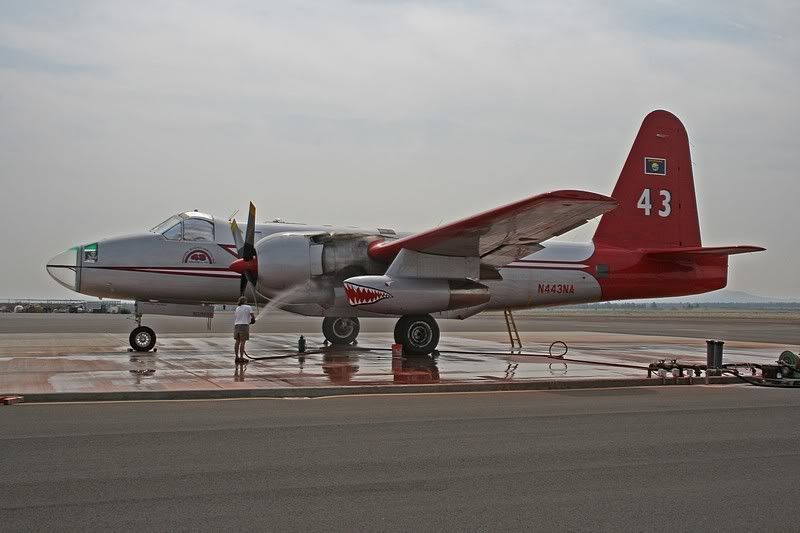
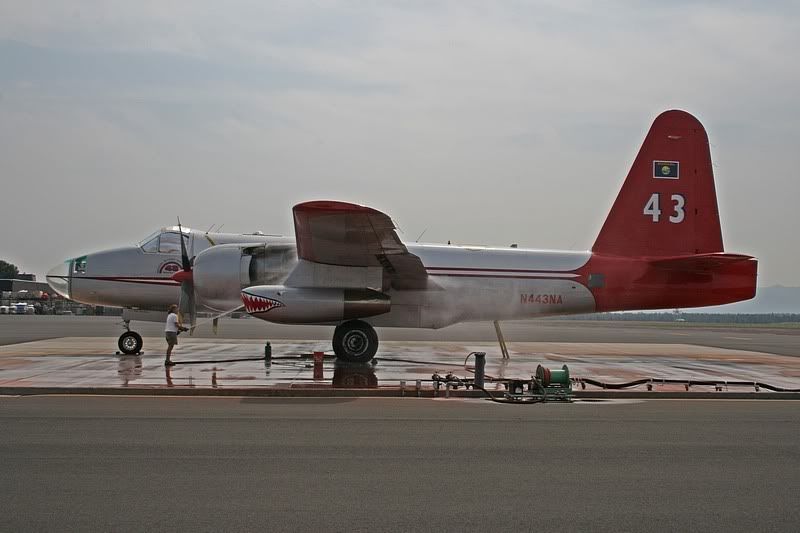

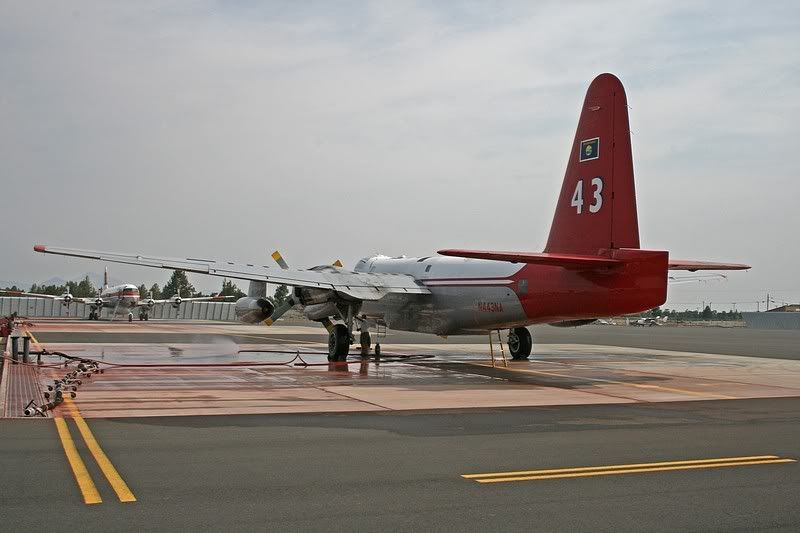
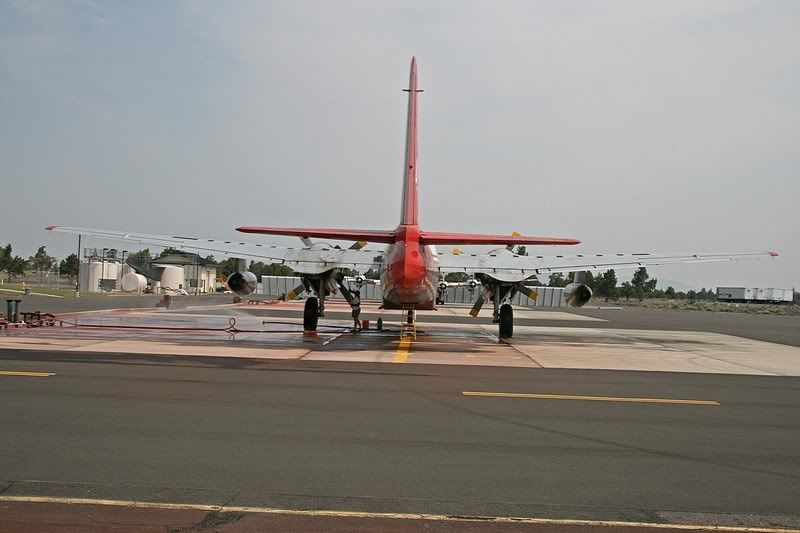
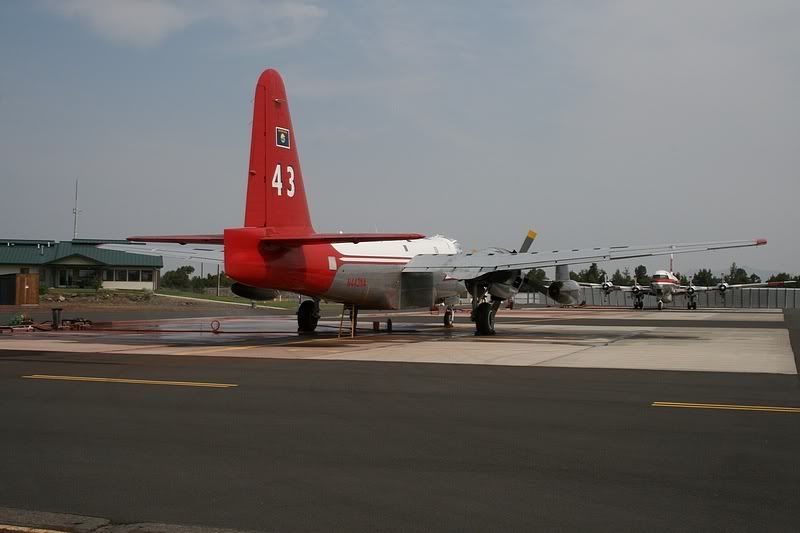

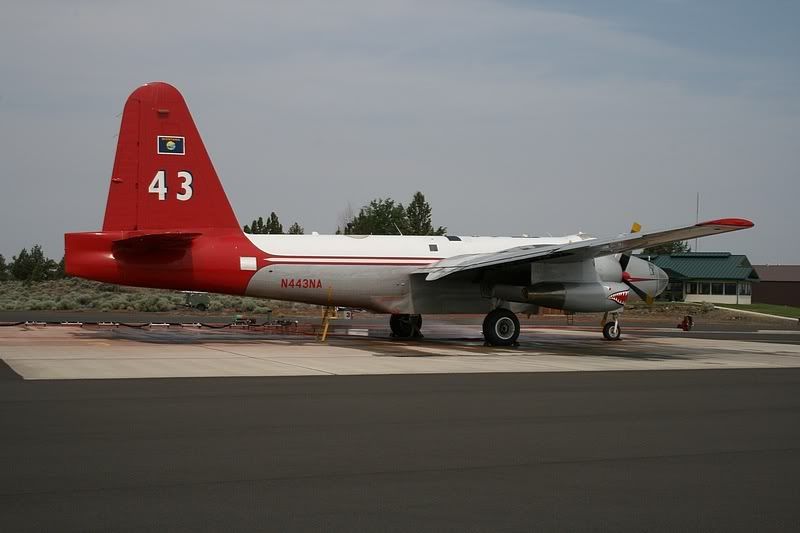
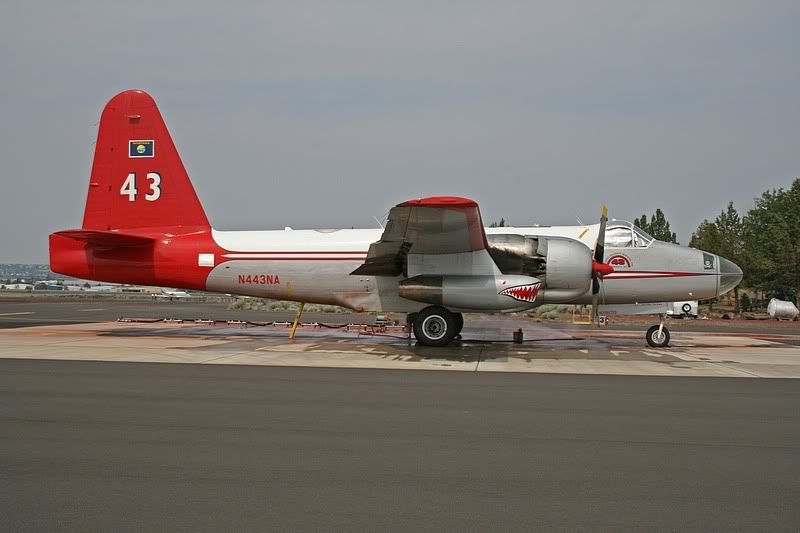
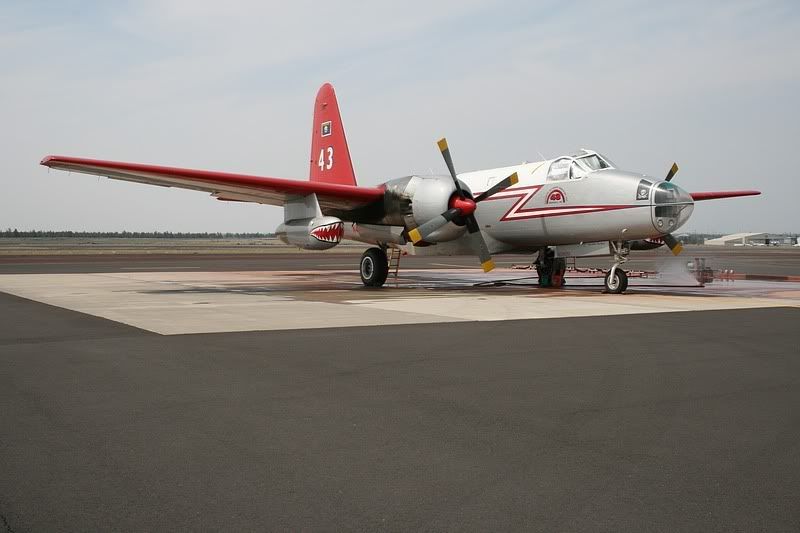

The entrance hatch is in the nosewheel well.This is looking forward just inside the hatch on the crawl way between the nose compartment and the hatch in the floor just behind the flight deck
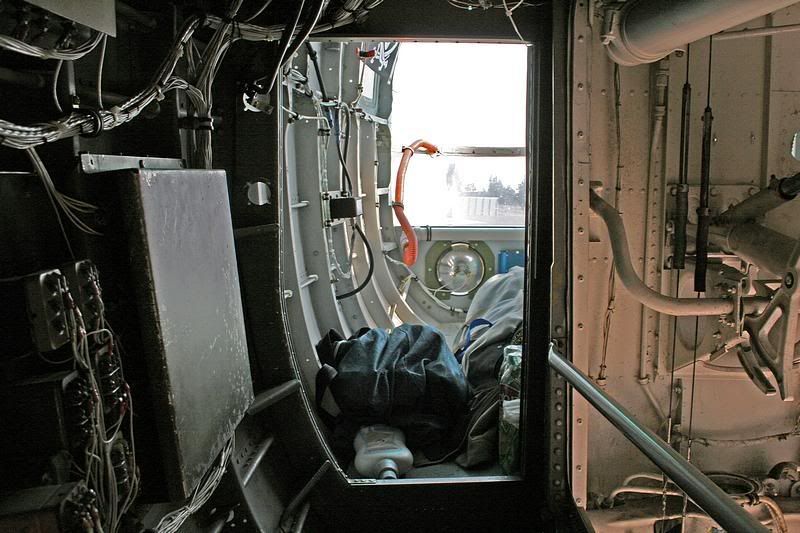
This is just to the right of the previous photo looking toward the nosegear
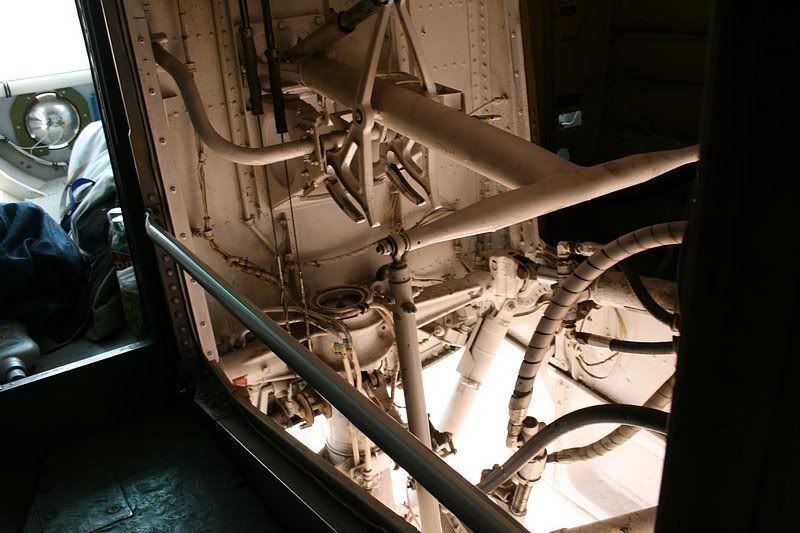
This is behind the flight deck looking forward.The hatch to the crawl way is at the left
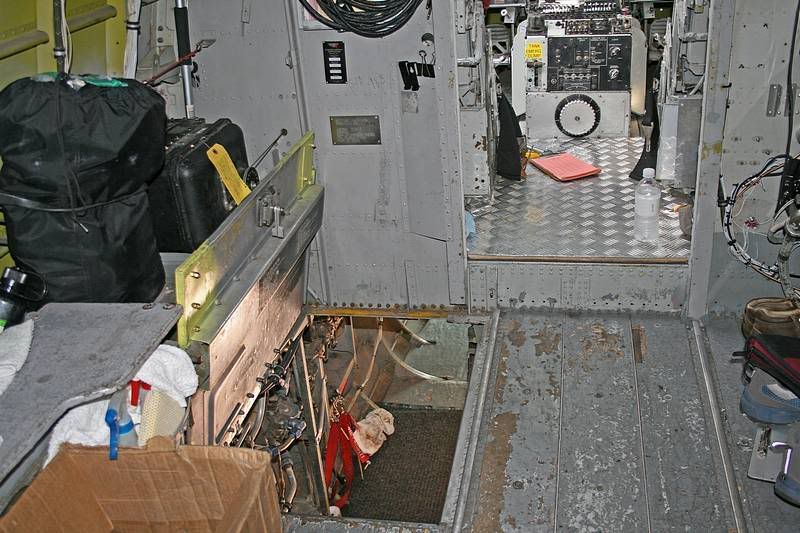
These pictures are looking aft from the position of the previous shot.
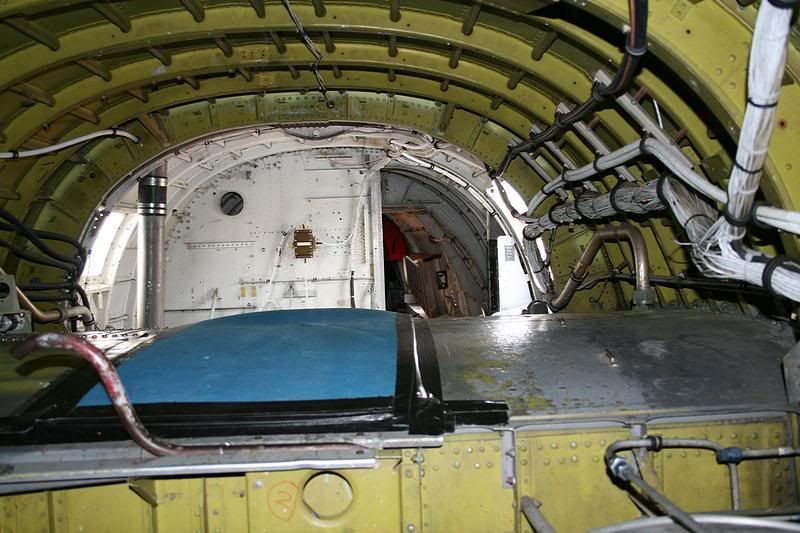
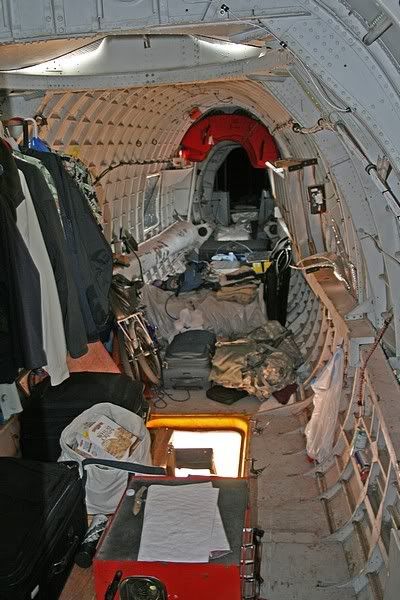
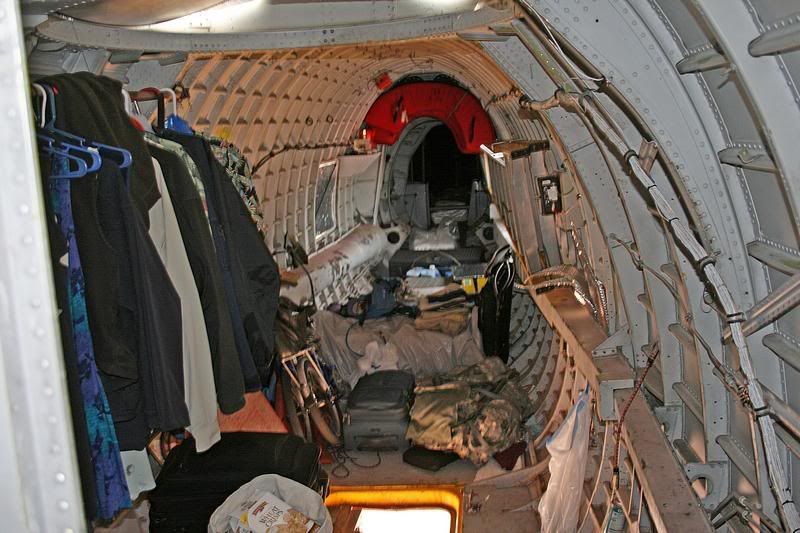
This picture is looking forward to the flight deck from behind the wing spar
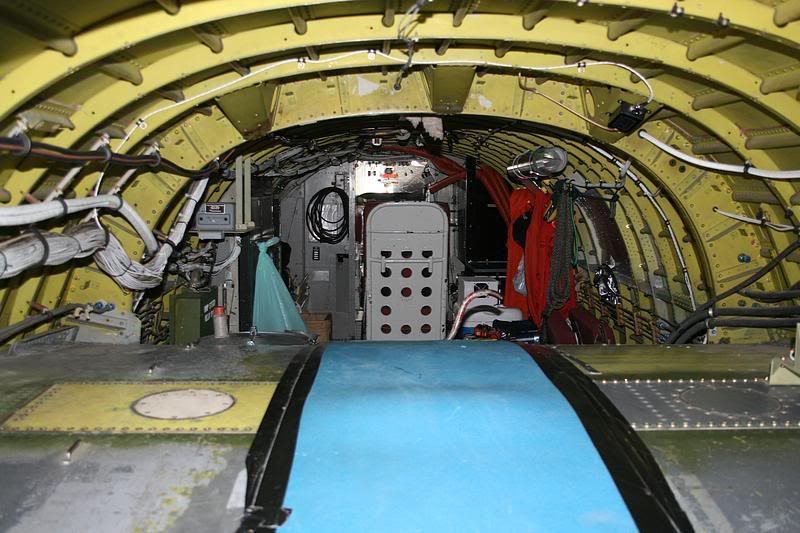
This is from forward of the spar
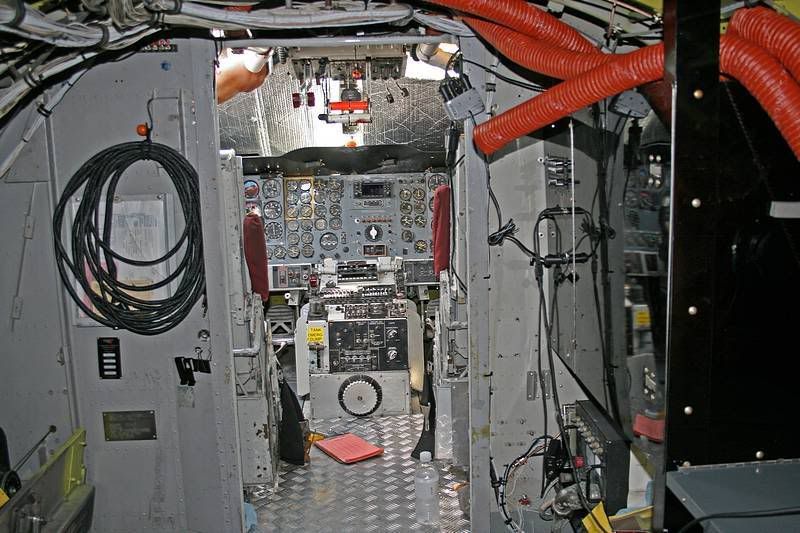
The flight deck/cockpit
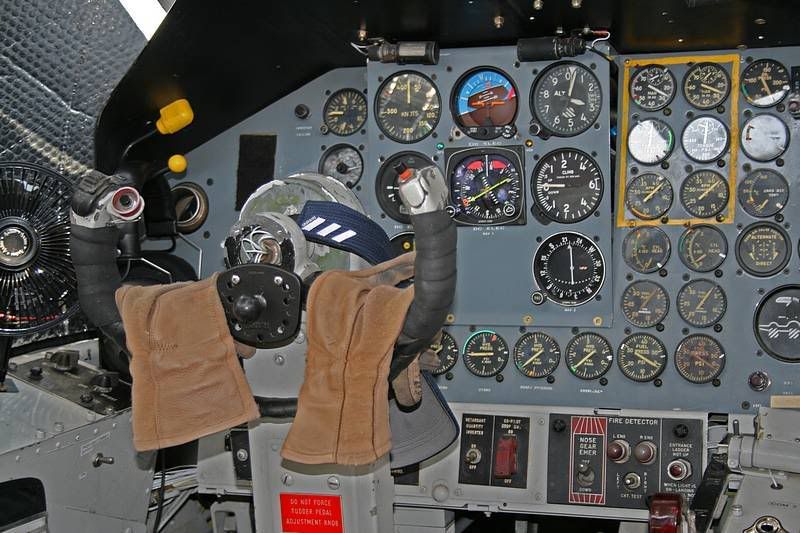
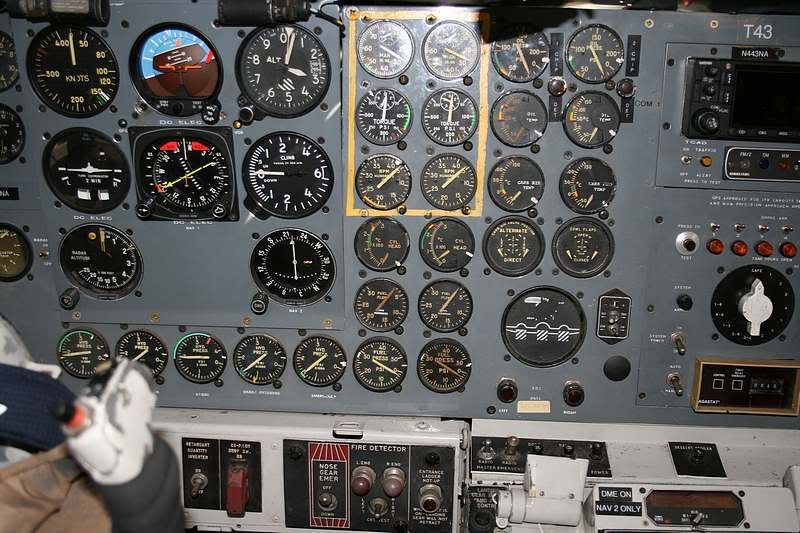
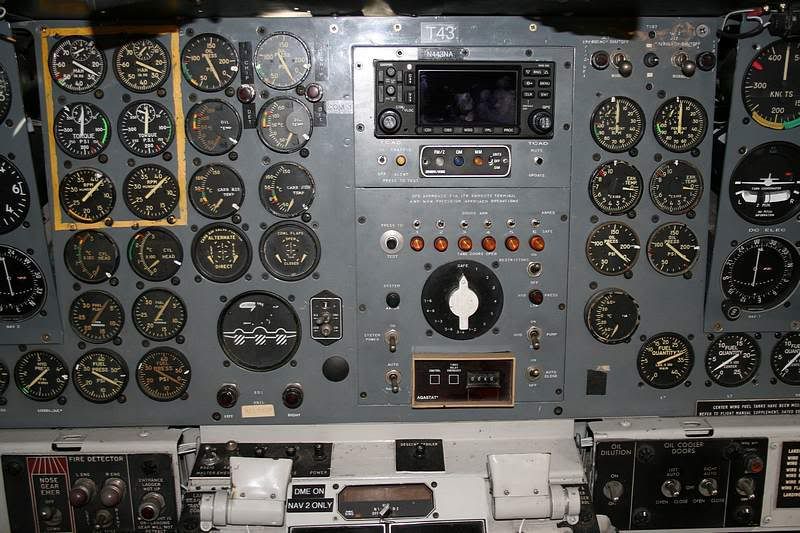
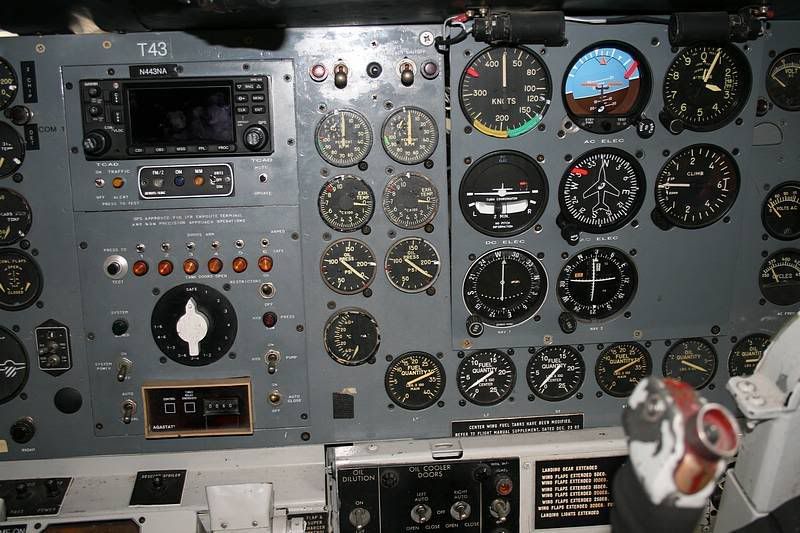
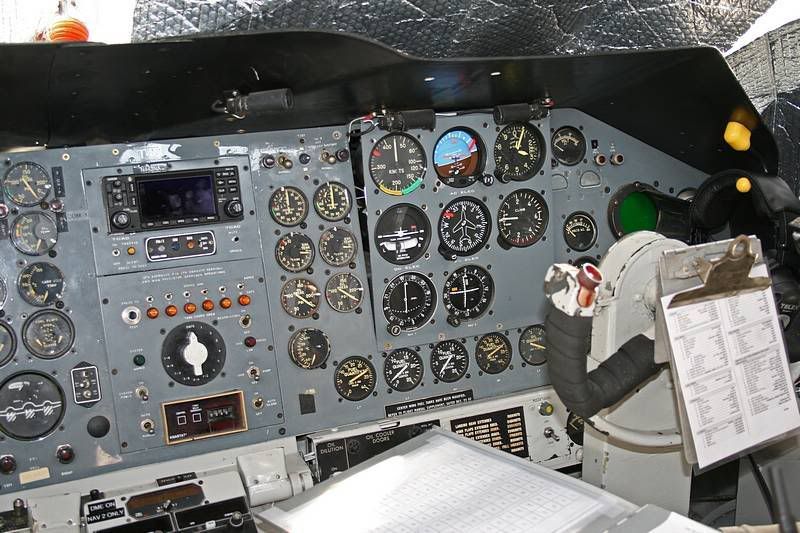

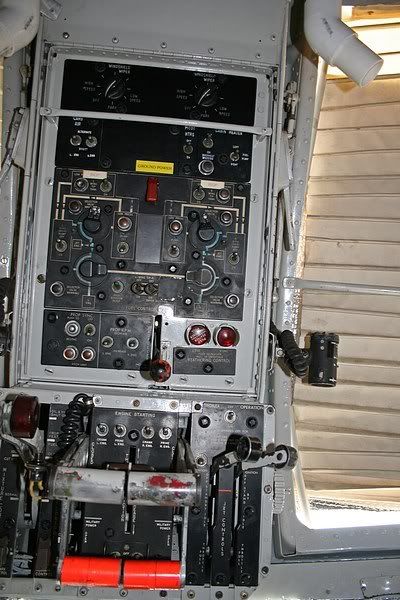
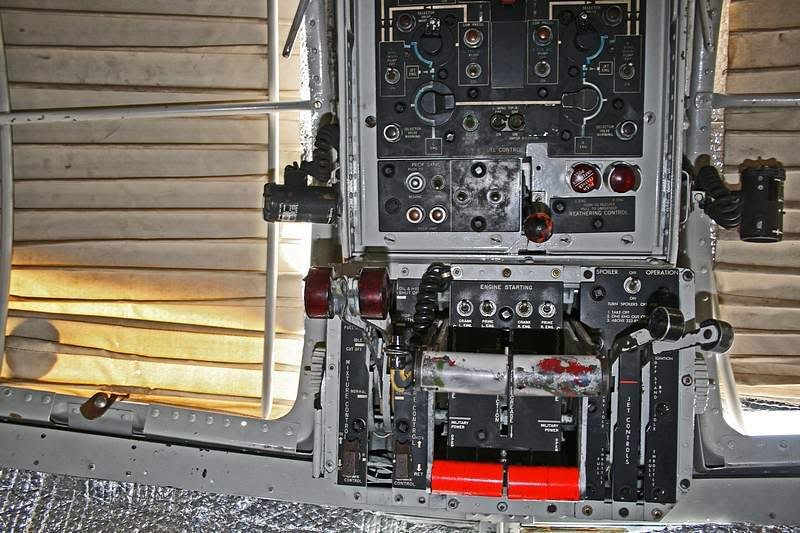
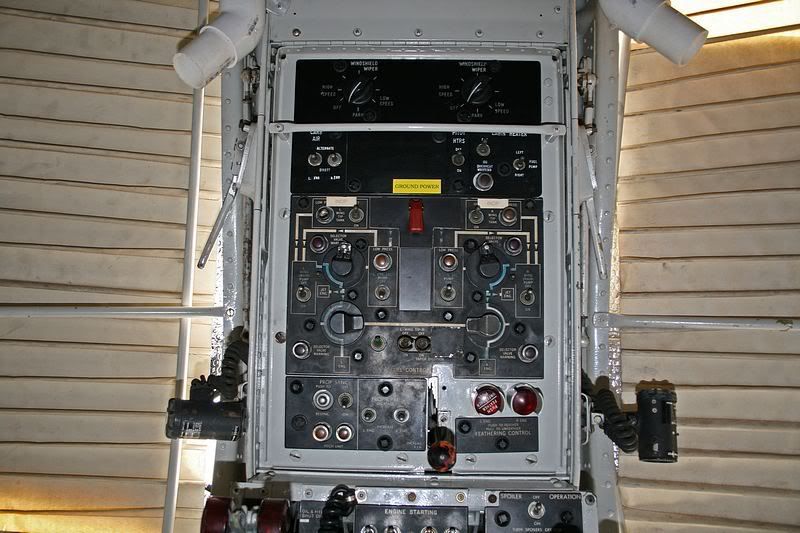














The entrance hatch is in the nosewheel well.This is looking forward just inside the hatch on the crawl way between the nose compartment and the hatch in the floor just behind the flight deck

This is just to the right of the previous photo looking toward the nosegear

This is behind the flight deck looking forward.The hatch to the crawl way is at the left

These pictures are looking aft from the position of the previous shot.



This picture is looking forward to the flight deck from behind the wing spar

This is from forward of the spar

The flight deck/cockpit











Tue Jul 08, 2008 7:59 pm
Larry ,Thanks so much for posting photos of the Neptune. It is one of my favorite airplanes. As an aside there is a derlect Neptune sitting at a VFW post here in Ohio. I have had a tour inside of it and all the military equipment seems to still be installed including a two burner electric cook stove. The piston engines and propellers are still installed and the pylons for the jets are also still there but the jets are long gone. Carl
Tue Jul 08, 2008 8:00 pm
Larry ,Thanks so much for posting photos of the Neptune. It is one of my favorite airplanes. As an aside there is a derlect Neptune sitting at a VFW post here in Ohio. I have had a tour inside of it and all the military equipment seems to still be installed including a two burner electric cook stove. The piston engines and propellers are still installed and the pylons for the jets are also still there but the jets are long gone. Carl
Tue Jul 08, 2008 8:15 pm
Larry, thanks for the Neptune pics. Great to see it being kept clean too. 
I don't want to tread on any toes or anything, but Flying Fireman wasn't Eric's only job for Bud, so if he was getting paid less, it was probably due to him also getting paid by Bud for his other work and other compensation that he was getting as well.
I will not proclaim that Bud has ever been a big spender when it comes to pay and I won't proclaim that some of his crews have been a bit out there, but unfortunately, that's what you get sometimes. He's a 1 plane operation with a small paycheck for the season from the State, so he made due with what he had. I know that Bud was pretty much forced into his rates by the WaDNR on the threat that they'd go elsewhere so one can't say that he was making a ton of money at the expense of the crews or anything else. His money went to maintaining the plane and getting the crews whatever he could afford. I'm not sure about the Credit Card situation as when I was at Air Tahoma everyone had cards and one was issued in Flying Fireman's name, but again, there may be issues about how the WaDNR contract was configured that may have dictated the use of checks instead of a corporate fuel card or credit card.
The thing I always point to with Bud is that in the entire history of his ventures (Cool Air / Renown, Flying Fireman, and Air Tahoma), he's had a pretty danged good safety record. Yes, sadly, there have been 2 fatal accidents (one Air Tahoma, one Flying Fireman), but beyond that, the only other accident they had was N150PA's gear-up during an FAA checkride at Boise, and that plane is still flying today out of Puerto Rico. He's always had a good safety record and always been pushing for more safety, but one can't prevent a human being from making mistakes or ending up with someone not really fit for tanker flying.
I just hope that all those years of great service to WaDNR doesn't end up going for basically nothing because of a single season and a potentially sub-standard crew.
I don't want to tread on any toes or anything, but Flying Fireman wasn't Eric's only job for Bud, so if he was getting paid less, it was probably due to him also getting paid by Bud for his other work and other compensation that he was getting as well.
I will not proclaim that Bud has ever been a big spender when it comes to pay and I won't proclaim that some of his crews have been a bit out there, but unfortunately, that's what you get sometimes. He's a 1 plane operation with a small paycheck for the season from the State, so he made due with what he had. I know that Bud was pretty much forced into his rates by the WaDNR on the threat that they'd go elsewhere so one can't say that he was making a ton of money at the expense of the crews or anything else. His money went to maintaining the plane and getting the crews whatever he could afford. I'm not sure about the Credit Card situation as when I was at Air Tahoma everyone had cards and one was issued in Flying Fireman's name, but again, there may be issues about how the WaDNR contract was configured that may have dictated the use of checks instead of a corporate fuel card or credit card.
The thing I always point to with Bud is that in the entire history of his ventures (Cool Air / Renown, Flying Fireman, and Air Tahoma), he's had a pretty danged good safety record. Yes, sadly, there have been 2 fatal accidents (one Air Tahoma, one Flying Fireman), but beyond that, the only other accident they had was N150PA's gear-up during an FAA checkride at Boise, and that plane is still flying today out of Puerto Rico. He's always had a good safety record and always been pushing for more safety, but one can't prevent a human being from making mistakes or ending up with someone not really fit for tanker flying.
I just hope that all those years of great service to WaDNR doesn't end up going for basically nothing because of a single season and a potentially sub-standard crew.
Wed Jul 09, 2008 8:06 am
Why do you suppose the P2 has the engine controls on the overhead? Is it just a throwback to seaplane patrol bombers, or is there some other design or operational rational?